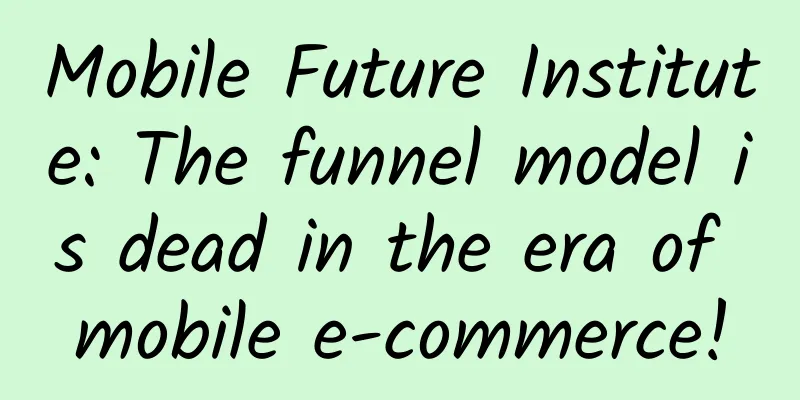Mobile Future Institute: The funnel model is dead in the era of mobile e-commerce!

|
Last year, I had the honor of chatting with Alibaba's Chief Intelligence Officer Che Pinjue, who mentioned that the "funnel model" should be transformed into an "equilateral triangle model". The context of the conversation was Alibaba's SNS and big data mining, which was essentially to solve the problem of matching massive products with consumer demand. Imagine if another context is added, in the era of mobile Internet, is the "funnel model" also outdated? This article was written by Chuck Martin, CEO of Mobile Future Institute, on Harvard Business Review. The original title of this article is "The Mobile Shopping Life Cycle". The core idea is that the funnel model of PC shopping era is not suitable for mobile shopping era. Now you need to build a new mobile shopping life cycle. Mobile is causing a dramatic change in the concept of "shopping path". The funnel model is almost the oldest marketing concept. The general user decision path is from attention, interest, desire and finally action. Marketers formulate strategies, communicate with users and exert influence around this concept. Now, with the advent of smartphones and tablets, marketers need to fundamentally rethink: shopping will become an iterative rather than linear process, and consumers no longer "go shopping" (Go Shopping), they are always shopping (Always Are Shopping). To adapt to this era, marketers must first realize that in the new era of mobile shopping, the traditional funnel model is dead and has been replaced by the new mobile shopping life cycle. When users use mobile terminals, marketers will have the opportunity to influence mobile consumer behavior and shopping decisions at different key moments. This is no longer an organized linear process, and shopping behavior will occur at any time. There are six distinct moments in the mobile shopping life cycle, as shown in the figure: How to influence consumers at the six nodes? 1. Pre-Buy stage. This is equivalent to the research stage of mobile shopping, because consumers will use mobile terminals before going to the store. At this time, the mobile phone is a pull medium rather than a push medium. Marketers need to follow up on the consumer's time period, mindset and location information to provide matching product information. 2. In Transit: This happens when consumers are on their way to a store or doing business. Marketers should provide targeted valuable information based on the location and speed of the user's phone to encourage them to open specific APP applications. 3. On Location Stage. In the early stages of the Internet, physical stores suffered greatly because Internet e-commerce could sell products to consumers at a lower cost. But in the era of mobile shopping, physical stores are becoming an asset. It should be pointed out that although some physical retailers are using mobile to interact with customers, most physical stores miss the opportunity to identify and communicate with customers when they are in the store. 4. Decision (Selection) stage. When customers are considering buying, marketers should use various technologies to interact with users in real time, and even use real-time pricing strategies. For example, when a group of users are close to a specific product, they can receive a real-time discount quote, and based on real-time inventory monitoring, the store can choose whether to change or stop the discount when the next group of users arrives. In addition, some simple technologies should be provided to allow consumers to scan the barcode of the product or compare prices in real time on the spot. 5. Purchase stage: This is another opportunity to influence consumers. Companies should provide mobile self-service payment services that are connected to the POS system, and promotional information should also be presented simultaneously during the user's purchase and payment process. 6. Post-Purchase Stage: Consumers will share photos, videos and information about recent purchases with friends and colleagues via mobile phones and social networks. The challenge for marketers is how to become a participant in the conversation between them. Source: Sohu IT Author: Chuck Martin |
<<: accenture: Providing more and better services to meet the needs of wireless users
Recommend
What are some exercises for sagging breasts?
Many female friends suffer from sagging breasts a...
The discharge is yellow
The vagina is a very important reproductive organ...
Why does my stomach feel tight and hard accompanied by fetal movement in the late pregnancy?
Generally speaking, in the later stages of pregna...
How to increase menstrual flow
If a woman has a small amount of menstrual blood,...
Silicone breast implants
Breast augmentation with silicone implants is cur...
What are the common reasons why women get wrinkles? Why are women prone to wrinkles?
Aging is a topic that everyone cannot avoid. One ...
What are the effects of removing one fallopian tube on women?
Removing one side of the fallopian tube has no ef...
Diagnosis and treatment of intrahepatic cholestasis of pregnancy
Some of you may have heard of the symptoms of int...
Still bleeding one month after giving birth
After ten months of pregnancy, the next most pain...
When do follicles begin to grow?
When people reach puberty at the age of 18, their...
What to check at 8 weeks of pregnancy
A woman's entire pregnancy lasts about 40 wee...
It's not moldy cheese, it's the smoker's lungs
When I was young, I especially liked to visit the...
Can I eat lollipops when I'm pregnant?
Lollipop is a very popular snack among children. ...
24 New Predictions for Social Media in 2017
Facebook 2016 was a year of great development for...
Overnight water or water that has been boiled thousands of times does not really cause cancer, but these foods must not be left until the next day!
Today we are going to discuss a very practical qu...









